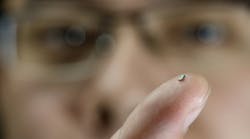Wireless Temperature Sensor Powered by Millimeter Waves
An extremely small temperature sensor devised by researchers from the Eindhoven University of Technology in the Netherlands is powered by the same radio signals it uses to communicate.
The sensor could represent a significant boon to the development of smart buildings, which will incorporate thousands of low-power wireless sensors to control lighting and heating systems. Because the sensor harvests energy directly from the radio waves, it does not need an external power source or batteries to stay turned on.
Based on 65nm CMOS technology, the device measures two square milimeters and weighs only 1.6 milligrams, making it what lead researcher Hao Gao claims is the world’s smallest temperature sensor. It consumes very little electricity in order to account for the inherent low input voltage taken from the radio signal.
Other wireless sensors can harvest energy from light or slight changes in pressure, but the temperature sensor — called Premiss — interacts with a specialized router that sends narrow radio beams directly into the device, which itself contains tiny antennas that capture the energy, Gao said.
Premiss, which weighs around the same as a grain of sand, is also unique for sending information with the same radio waves that power it. The outgoing signal has a slightly different frequency depending on the temperature, and the router can determine the temperature based on that frequency, Gao said.
As an added bonus, the antennas can function beneath a layer of paint, plaster, or concrete. Peter Baltus, a professor of wireless technology at Eindhoven University, said that this quality makes it easier to incorporate into buildings. He suggests that it could be painted onto walls with latex paint.
In spite of the potential benefits, the temperature sensor is far from finished. It has only been shown to capture energy from a distance of 2.5 centimeters. The researchers expect to increase the range to a meter within the next year. After that, the researchers will target a range of 5 meters, Baltus said.
Other recent advances in harvesting radio waves include the Power Over Wi-Fi system invented by researchers at the University of Washington. It harvests energy from untapped, ambient Wi-Fi signals, using a router that sends out a superfluous “power packet” on Wi-Fi channels not being used for transmitting data.
Premiss operates over the 60 GHz frequency band, which is why the high-frequency antennas inside the temperature sensor can be made so small. The antennas can also be manufactured at an extremely low cost for other sensors measuring motion, light, and humidity, the researchers said.
